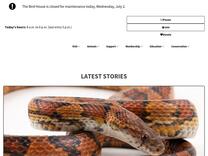African plated lizard | Smithsonian’s National Zoo and Conservation Biology Institute https://nationalzoo.si.edu/animals/african-plated-lizard
There are 30 species of plated lizards, and the African plated lizard (also called the giant plated lizard) is one of the largest. It has a squat body, plate-like scales and powerful legs.
The subspecies G. v. maltzahni is found in central and southwest Namibia and in southern

